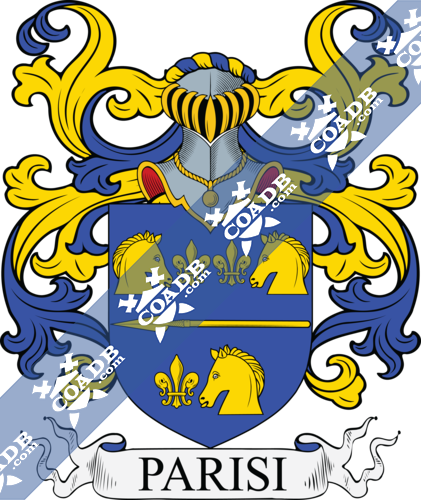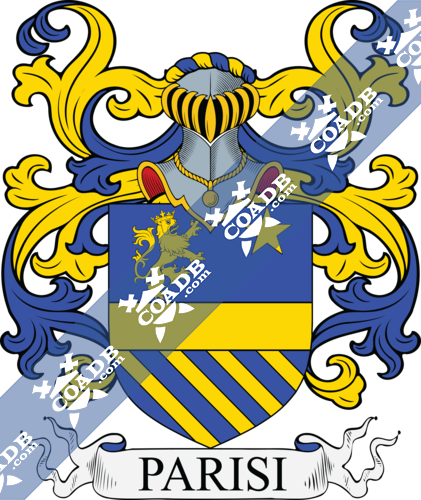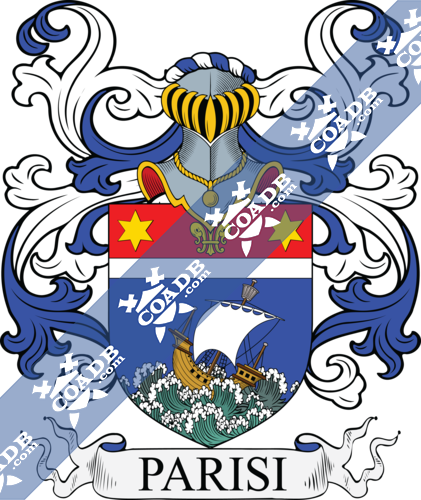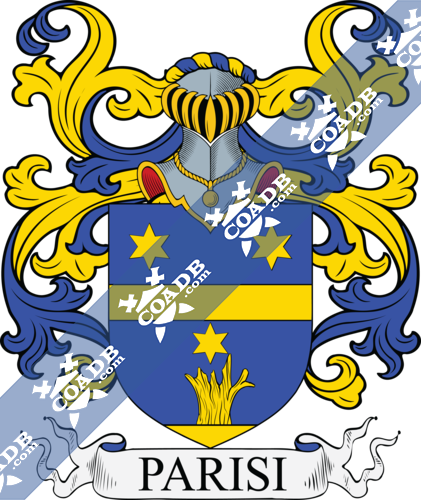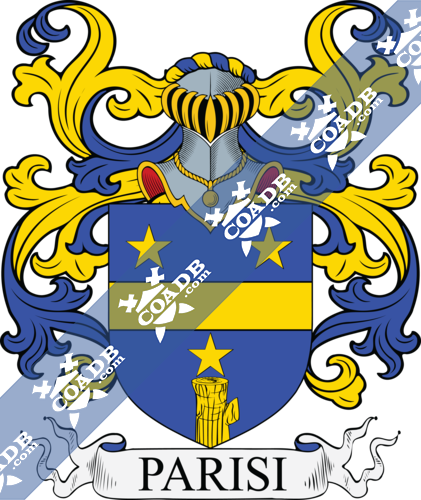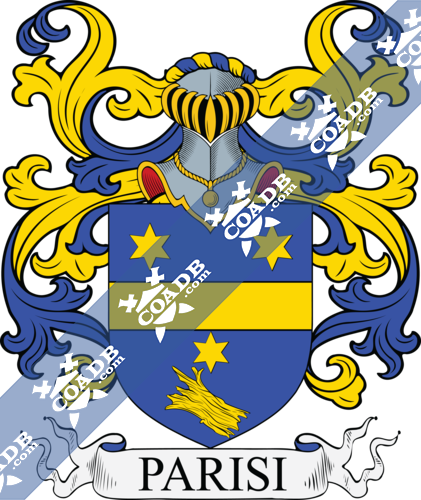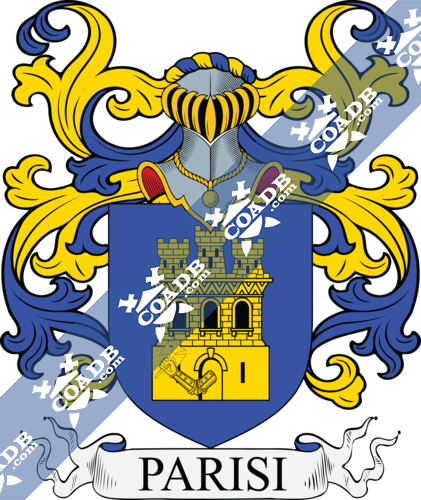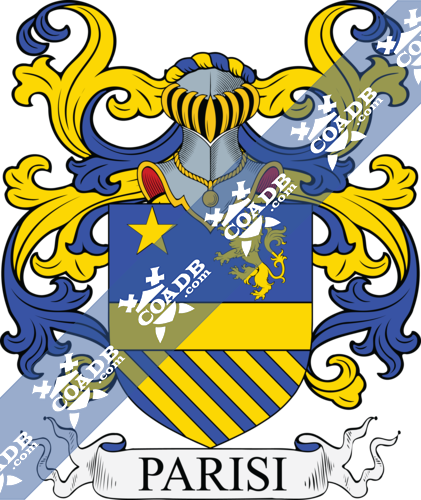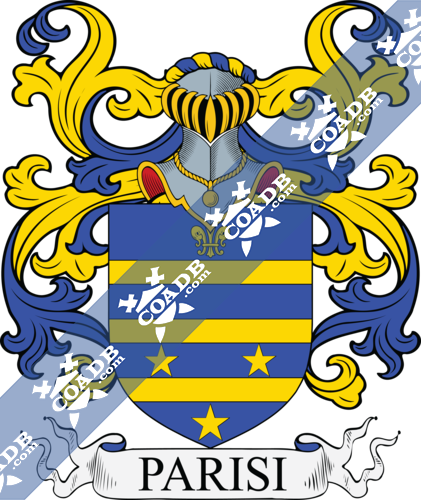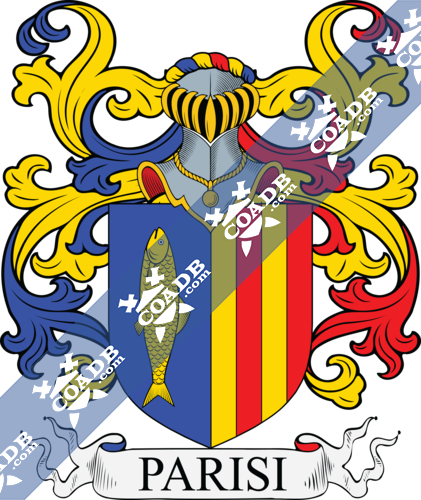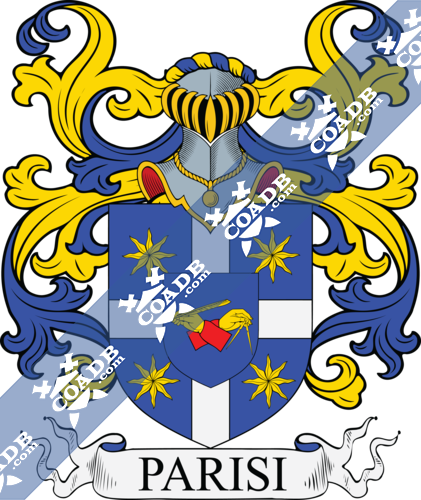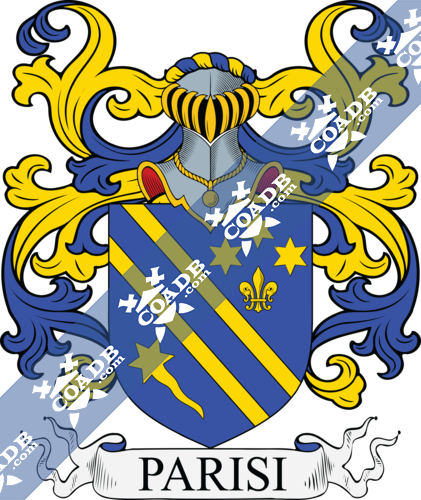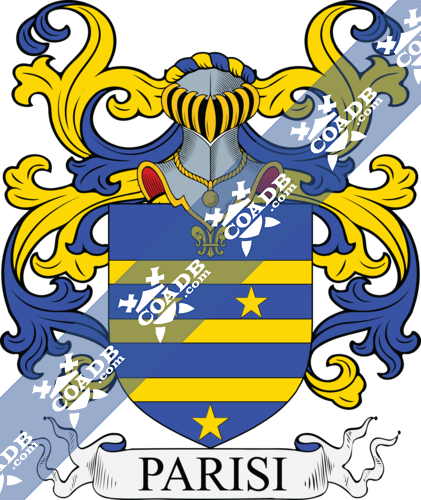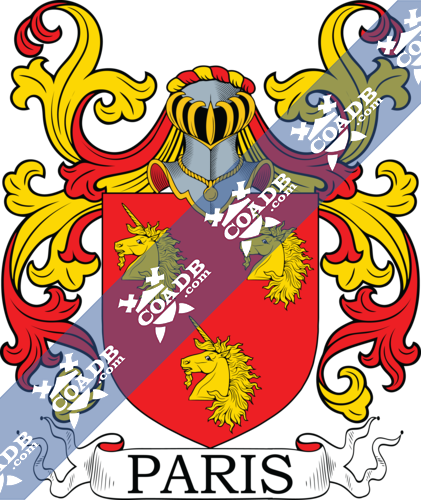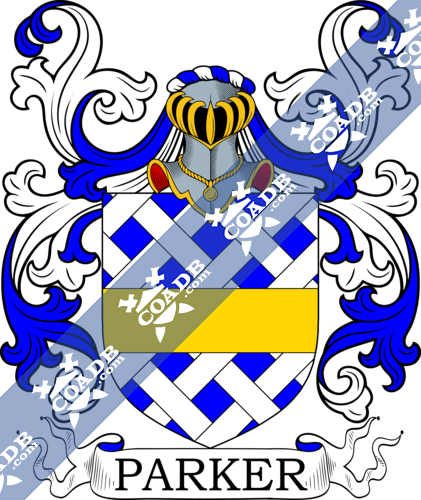Parisi Family Crest, Coat of Arms and Name History
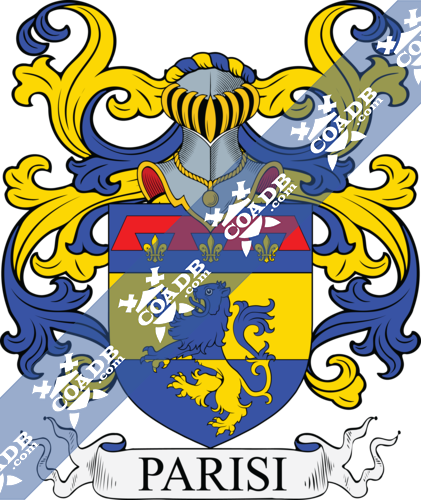
Parisi Coat of Arms Gallery
Don’t know which Coat of Arms is yours?
We can do a genealogical research. Find out the exact history of your family!
Learn MoreParisi
Origins:
There are three different theories which explain the origin of the name Parisi. These are as follows.
One theory claims that the word Parisi has its origins in the word “Paris”, the capital city of France. Although the phonetic similarity cannot be discounted, this hypothesis has been rejected by almost all scholars as Parisi has been mentioned in documents and histories that predate the formation of Paris.
A popular hypothesis is one that connects the word with ancient Gaul. According to some scholars the word Parisi may have been taken up by a break away tribe of Gaelic origins. These people may have been called “kwarjo” at first but later on the “kw” was replaced by “p” due to easier pronunciation and the tribe took on the name Parjo, literally meaning “people of the kettle”. Another shift in pronunciation changed this to Parisi and the modern day name was thus born. This hypothesis is especially popular due to written records of various cities bearing this name, such as Lutetia Parisiorum; which has been called by various historians as “the prime location” of the Parisi Tribe in the third century AD.
Another popular theory, favored by many historians due to its ability to explain contemporary connection of the Parisi tribe with the Italian city of Sicily, is one that states that the Parisi are connected to Hellenic ancestors. According to this theory the Parisi originated in the town of Paglia in modern day Italy, which was conquered by the Romans in the third century BC. However before this time the entire area was under strong Greek influence. Records who that an ancient town by the name of Parisi existed at this time in this area, and continued to flourish even after the Roman conquest was completed in 55 BC.
Variations:
There are many variations of this name. The most common are
Parisi; the most common
Parise(with an ‘e’, Paris (seldom used these days but was common in the previous centuries)
Parisio and Pariso (both are derived from Parisi and not from Paris)
Pari, Parissi and Parris (the product of addition and subtraction of phonemes)
Parice, Parici and Paricio (The ‘s’ is substituted for a ‘c’, the vocalization remains the same however)
Aparicio and Parish (derived by additions before and after the root word)
History:
The history, which most scholars agree upon, starts from Sicily in Italy. The Parisi were found in this area when modern record keeping began. However before this time there are contradictory theories about the history of the Parisi depending on which theory of origin is preferred.
If the origin is accepted in Gaul then the Parisi are said to have been an iron age tribe which settled the are before the Romans arrived. They were on the forefront of resistance against the Romans and when Vercingetorix rebelled against the Romans, it is claimed that many of his 8000 men were from the Lutetia area wherein the Parisi tribe resided and were therefore Parisi. According to this theory the Parisi ended up in Sicily because at the start of the Norman Conquest one of their tribesmen Gualterio Parisi, who had rendered great service to the emperor arrived in Italy, and was awarded six large tracts of land as a reward for services rendered. After this Sicily became the home of Paris people.
However if we are to believe that the Parisi are from Hellenic descent then according another theory, they were already present in Italy before the Romans arrived and were highly influenced by Greek culture. When the Romans attacked, they sought refuge in northern lands and were pushed further and further north until they came to reside in modern day France. However as the Romans pushed forward, the Parisi sought refuge in Britain where the Celts resided. Upon arriving in Britain they established various towns such as Petuaria. According to this theory the entire Dewyr area was under Parisi influence before the Roman conquest. After the Roman Conquest they may have moved back to their homeland in Italy.
Notable People:
Notable Parisi include,
Buongiovanni Parisani (1304): He was the mayor of the town of Tolentino
Giovanni-Antonio Parisani(1420) He was nominated as the bishop of Fano by the Pope.
Ascanio Parisani(1430) He was nominated as the Bishop of Cajazzo and eventually took office as the Cardinal during the papacy of Paolo the third.
Francesco Parisi (1930-2016) Renowned as a political personage in Italy
Francesco Parisi (b. 1962) Renowned economist who held the chair of professorship at various international universities.
Giovanni Parisi (1967-2009) Renowned boxing champion who held the lightweight title from 1992-1994 and the Welterweight title from1996-1998. He Also won the Gold Medal at the Olympics.
Giorgio Parisi (b. 1948) Renowned physicists who specializes in Quantum physics.
Arturo Parisi (b. 1940) Held the ministry of Defense in Italy from 06-08
.
Blazons & Genealogy Notes
1) Bologna – Spaccato d’oro e d’azzurro, al leone dell’uno nell’altro; col capo d’Angiò. English: Per fess gold and blue, a lion over all per fess blue over gold; a chief of Angio.
2) Cosenza e Palermo. – D’azzurro, ad un castello merlato d’oro, con un braccio armato impugnante una croce patente d’oro, sporgente dalla porta. English: Blue with a castle walled of gold. with an armoured arm holding a cross patente of gold, protuding from the door. Source: Dizionario Storico, G. B. Di Crollalanza, 1886.
3) Fiumedinisi (Sicilia). – D’azzurro, a cinque cotisse d’oro, abbassate sotto una fascia in divisa, sostenente un leone coronato, guardante una stella posta al primo cantone, il tutto dello stesso. English: Blue, 5 cotisse of gold, lowered to a fess surmounted by lion crowned looking at a star posted in the first canton, all gold. Source: Dizionario Storico, G. B. Di Crollalanza, 1886.
4) Reggio Calabria – D’azzurro, alla fascia d’oro, accompagnata in capo da due stelle, ed in punta da un tronco d’albero e da una stella, il tutto d’oro. English: Blue with a fess gold, accompanied in chief by 2 stars and in point by the trunk of a tree and a star, all gold. Source: Dizionario Storico, G. B. Di Crollalanza, 1886.
5) Sicilia – D’azzurro, a tre fascio accompagnate da un giglio nel capo e da tre stelle poste due sotto la prima fascia, ed una in punta, il tutto d’oro. English: Blue, 3 fesses gold, accompanied by a fleur di lis in chief and 3 stars posted over the first fess, and in point, all gold. Source: Dizionario Storico, G. B. Di Crollalanza, 1886.
6) Venezia – Partito; nel 1° d’azzurro, ad un pesce d’oro posto in palo; nel 2° palato d’oro e di rosso di quattro pezzi. English: Per pale; 1st blue with a fish gold posted in pale; 2nd paly of 4 gold and red. Source: Dizionario Storico, G. B. Di Crollalanza, 1886.
7) Mineo e Lentini (Sicilia). – D’azzurro, ad una lancia posta in fascia, accompagnata da tre teste di cavallo recise, le prime due nel capo affrontate, miranti due gigli, la terza in punta, addestrata da un giglio, il tutto d’oro. English: Blue, a spear posted in bend, accompanied by three horse heads severed; the first 2 in chief affrontate (looking at each other) and 2 lillies between them. the 3rd in point. Source: Dizionario Storico, G. B. Di Crollalanza, 1886.
8) Modena , Modena, Emilia – 2 mani destra e sinistra conserte di carnagione con i polsini di rosso la sinistra in alto regge una penna di oro la destra regge un compasso aperto le punte al basso di oro tutto su scudetto di azzurro su – croce di argento accantonata da – 4 stelle (8raggi) dello stesso tutto su oro. English: 2 left and right hands folded red wristbands with the complexion of top left holding a gold pen right holds a compass open tips to bottom of all gold on silver cross on Blue Shield-set aside from-4 stars (8raggi) of all about gold. (Source: Leone Marinato).
9) Palmero, Palermo, Sicilia – Roma, Roma, Lazio – Gemella in banda accompagnata in basso da una cometa posta in banda e a sinistra da – un giglio e 3 stelle (6raggi) poste 1,2 in alto tutto di oro su azzurro. English: Mate in band accompanied at the bottom by a comet in-band and left mail from-a lily and 3 stars (6raggi) 1.2 and higher all of gold on blue. (Source: Leone Marinato).
10) Palmero, Palermo, Sicilia – Roma, Roma, Lazio – 3 fasce di oro su azzurro – giglio di oro in alto su azzurro – 3 stelle (5raggi) di oro poste 2,1 2 tra le prime 2 fasce e una in punta su azzurro. English: 3 bands of gold on blue-gold Lily on blue-3 stars (5raggi) of gold placed 2,1,2 among the top 2 bands and a toe-on blue. (Source: Leone Marinato).
11) Palmero, Palermo, Sicilia – Roma, Roma, Lazio – Fascia di oro su azzurro – leone rampante coronato rivolto di oro mirante – stella (5raggi) dello stesso in alto a destra tutto su azzurro – 4 bande di oro su azzurro in basso. English: Band of gold on blue-gold crowned lion rampant turned mirante-Star (5raggi) in upper right corner all about Blue-4 bands of gold on blue bottom. (Source: Leone Marinato).
12) Trieste, Trieste, Venezia and Giulia – Nave provvista di un solo albero e di una sola vela navigante su mare in tempesta al naturale su rosso – giglio di argento affiancato da – 2 stelle (6raggi) di oro tutto su azzurro in capo – trangla di argento. English: Ship with only one tree and one sail sailing on stormy sea al naturale on red-silver Lily flanked by-2 star (6raggi) of all gold on Silver Blue garment-trangla. (Source: Leone Marinato).
13) Napoli, Campania – Fascia di oro su azzurro – 2 stelle (6raggi) di oro poste in fascia su azzurro in alto – tronco di albero nodrito su campagna di oro sormontato da – piccola stella (6raggi) dello stesso su azzurro in basso. English: Band of gold on blue-2 star (6raggi) of gold placed in band on top blue-tree trunk nodrito on gold topped by campaign-little star (6raggi) thereof on blue bottom. (Source: Leone Marinato).
14) Palermo, Sicilia and Roma, Lazio, and Benevento, Campania – Fascia di oro su azzurro – 2 stelle (5raggi) di oro poste in fascia in alto su azzurro – tronco di albero di oro uscente dalla punta sormontato da una piccola stella (5raggi) dello stesso su azzurro. English: Band of gold on blue-2 star (5raggi) of gold placed in band at the top of blue-tree trunk of gold coming from punta surmounted by a small star (5raggi) thereof on blue. (Source: Leone Marinato).
15) Cosenza, Calabria – Fascia di oro accompagnata da – 3 stelle (6raggi) poste 2,1 dello stesso su azzurro – tronco di albero tagliato posto in banda in punta di oro su azzurro. English: Gold range 3 star (6raggi) accompanied by-2.1 thereof on blue-tree trunk cut place band in gold tip to Aqua. (Source: Leone Marinato).
16) (or Parisio). Cosenza, Calabria. Drago alato passante testa di rivolta di verde su terrazzo dello stesso su azzurro afferrante con la bocca una freccia di argento posta in sbarra punta in alto accompagnato da – un artiglio di rosso uscente da destra sostenente un tronco al naturale posto in banda su azzurro in alto. English: Winged Dragon green revolt head on through-deck thereof on grabbing Silver Blue mouth an arrow tip top bar accompanied by mail-retiring a claw right red natural trunk supporting a place in top blue band on. (Source: Leone Marinato).

